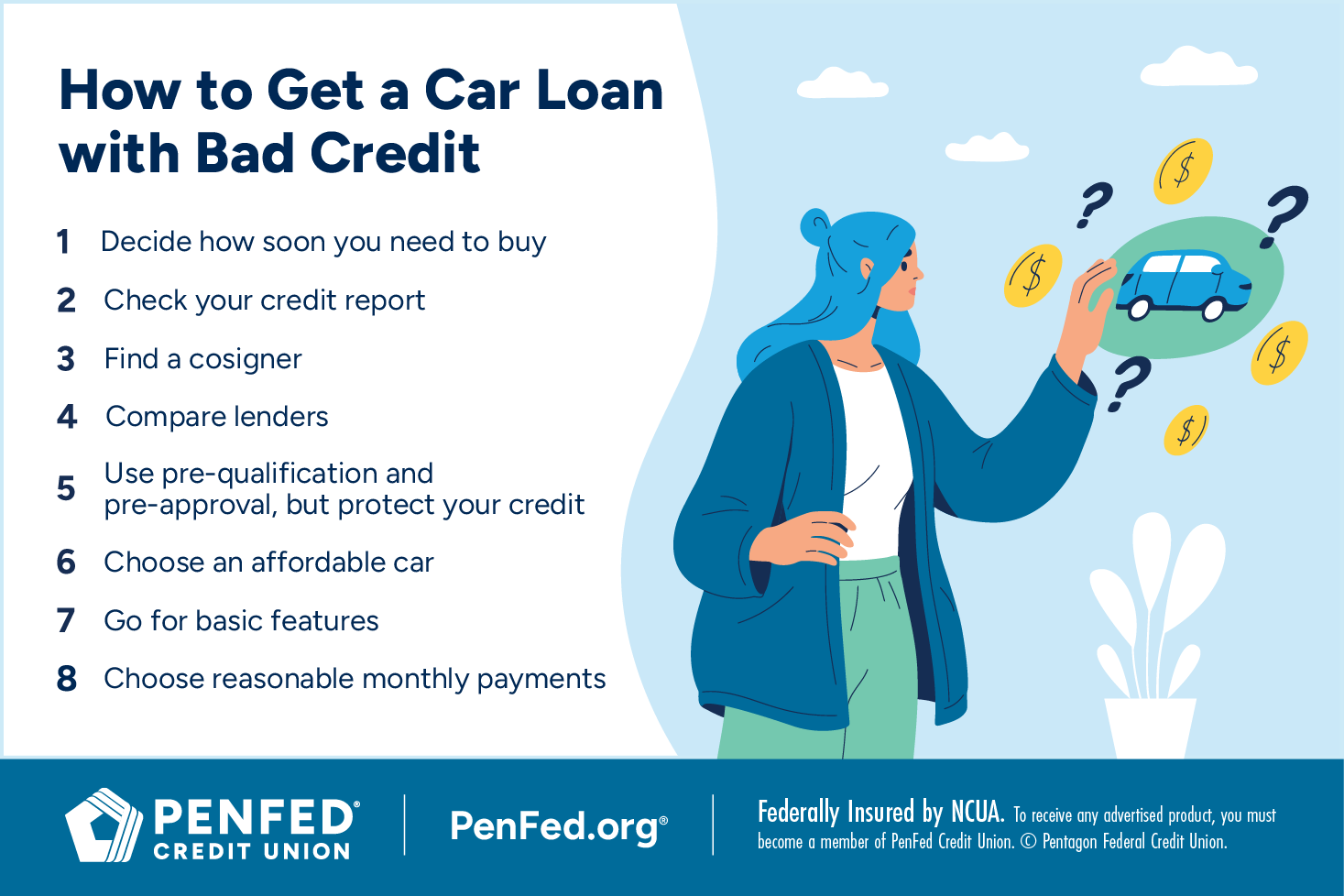AUTO
How to Buy a Car With Bad Credit
EXPECTED READ TIME:9 Minutes
Buying a car isn’t easy. There are so many details to consider, from picking a vehicle to figuring out how best to finance it.
Unfortunately, it’s even more complicated with bad credit — but it’s not impossible. Let us show you how to buy a car with bad credit.
How Bad Credit Affects Your Car Loan
Your credit score is one of the most important factors in getting approved for a car loan. Credit scores are made up five main factors, the most important being your payment history.
Lenders do an in-depth credit check before approving a loan because they want to know if you’ll repay what you borrow. If your credit report shows things like late payments, missed payments, or lots of existing debt, a lender might charge you higher interest to offset their risk in lending to you.
The chart below shows how interest rates for auto loans increase for those with lower credit scores.
|
Credit Score |
Average Interest Rate for New Cars |
Average Interest Rate for Used Cars |
|---|---|---|
|
781-850 |
4.77% |
7.67% |
|
661-780 |
6.40% |
9.95% |
|
601-660 |
9.59% |
14.46% |
|
501-600 |
13.08% |
19.38% |
|
300-500 |
15.75% |
21.81% |
*Average rates as of December 2024
How to Get Approved for a Car Loan With Bad Credit
It may seem impossible, but you can get approved for a car loan even if you have bad credit. Here are some steps to get you started.
1. Decide How Soon You Need to Buy
Sometimes a new car can’t wait.
But other times you have some lead time on your car purchase. If you can wait, you might benefit from improving your credit score, saving for a bigger down payment, or researching different lenders before trying to buy.
It’s tempting to rush to purchase a car — especially if you’re facing serious hurdles without one — but auto loans are long-term commitments that will shape your finances for between three and seven years on average. It’s important to get the best rate and term possible.
2. Check Your Credit Report
Checking your credit report will help you figure out what lenders are likely to approve you. You can check your report for free once each year.
Your credit report will also tell you what you need to do to improve your credit score. Start working right away to improve your credit by:
Getting overdue accounts paid up to date
Paying off (or paying down) any existing debt
Checking for and fixing errors in your credit report
Don’t take out any new credit cards or loans if you’re planning to buy a car. Opening new accounts signals to auto lenders that you’re taking on other forms of debt that could make it harder for you to pay back your car loan. New accounts can also temporarily drop your credit score.
It may seem impossible, but you can get approved for a car loan even if you have bad credit.
3. Find a Cosigner
A cosigner is a co-borrower who agrees to take responsibility for a loan if you become unable to pay it. Having a cosigner whose credit is stronger than yours reduces the risk for your lender, which may help you get approved for a loan you’d otherwise not qualify for.
4. Compare Lenders
You’ll find a better deal if you compare multiple lenders. Every auto lender sets their own standards for loan approval, which means some lenders may approve you while others turn you down. Some lenders may also offer more favorable terms than others.
Some states have nonprofit agencies that provide auto loans to low-income residents. These loans may come with lower rates or more flexible terms than for-profit lenders can offer, so it’s a good option to explore. You can find these lenders online by searching terms like “nonprofit auto loans.”
Some states have nonprofit agencies that provide auto loans to low-income residents.
5. Use Pre-qualification or Pre-approval, but Protect Your Credit
Many auto lenders offer pre-qualification or pre-approval for potential borrowers. Although they sound similar, pre-qualification uses a soft credit check to create an estimate for what you can borrow and on what terms. Pre-approval uses a hard credit check and provides the exact amount you’ll be able to borrow, at what interest rate, and for how long.
It’s better to get pre-qualified when you’re exploring multiple lenders and save pre-approval for when you’re feeling more confident that a specific lender will approve you with acceptable terms. That way your credit score won’t take a hit for multiple hard checks.
Multiple hard inquiries from loan applications sometimes count as one inquiry for scoring purposes. But it depends on the type of loan, the type of credit score and when the creditors request your credit reports. For example, VantageScore counts multiple hard inquiries from a 14-day period as one inquiry.
6. Choose an Affordable Car
It’s easy to overestimate your car budget if you’re not thinking about the true cost of car ownership. Remember, you’ll need to pay for insurance, maintenance, and fuel each month in addition to making your car payment.
You may find you need to spend less on the car itself so you can afford everything that goes with car ownership. If that’s the case, consider whether you should buy a new or used car.
It’s easy to overestimate your car budget if you’re not thinking about the true cost of car ownership.
7. Go for Basic Features
Some car dealerships try to upsell by offering extra features like nitrogen fill for tires, upholstery protection, or extended warranties. These extras can add a lot to the total cost of your vehicle. You’re better off skipping the extras and focusing on a reliable base model you can more easily afford.
8. Choose Reasonable Monthly Payments
Some lenders offer longer loan terms that seem appealing because they lower your monthly payment. Lower monthly payments mean you can buy a more expensive car, right?
Not quite. The longer you pay on your car, the more total interest you’ll pay. You’ll save more overall purchasing something within your budget and paying it off sooner.
At the same time, don’t commit to monthly payments that are so big you struggle to make full payments consistently. Buying a car is a great opportunity to use debt wisely and rebuild poor credit.

Where to Get a Car Loan With Bad Credit
You can get an auto loan from many types of lenders, but some will offer better terms than others. When considering a lender’s offer, you need to look at:
The amount you can borrow
The interest rate
How long you have to repay the loan (the term)
Additional fees
Besides comparing the offers themselves, read reviews for each lender you’re considering. Some may have hidden fees or use tactics that make it harder to repay your loan. Others, on the other hand, may offer rate discounts for car buying programs or automatic payment (autopay) agreements. You’ll have a much better experience with a lender who is honest, is transparent, and offers good customer support and services.
You’ll have a much better experience with a lender who is honest, is transparent, and offers good customer support and services.
Banks and Credit Unions
Your current bank or credit union is a great place to start looking for auto loans. These institutions usually offer the best interest rates and fees, and they are likely to offer pre-approval so you know exactly what your terms will be before you commit.
Credit unions in particular offer outstanding lending options. Members may be eligible for special financing and their odds of approval are much higher. Credit union loans also have fewer fees and lower interest rates than banks.
Online Lenders
Online lenders offer competitive terms on auto loans, and you can complete the entire process online. They can approve your application fast, speeding up your car buying process. Just be sure to research unfamiliar companies carefully to avoid scams.
Captive Financing
Many automakers have their own lending divisions that allow you to buy directly from the manufacturer. These captive financing companies can be more flexible than dealerships and often offer the best annual percentage rates (APRs) on the market. They may be more forgiving of poor credit if you can provide proof that you’re able to pay your loan.
The downsides are that not all automakers offer captive financing, and some do only offer financing for those with credit scores of 620 or higher.
While going through a dealership is convenient, there can be downsides.
Car Dealerships
Dealerships usually have networks of lenders they work with or have in-house financing departments. While going through a dealership is convenient, there can be downsides — especially with buy-here, pay-here financing:
High-Pressure Sales Tactics: Dealerships often pressure customers to buy more expensive cars or purchase expensive upgrades. They may even approve you to borrow more money so you can cover these added costs even if that’s not the best financial decision for you.
High Cost: Dealerships are known to mark up interest rates and charge more fees overall to process loans. In fact, many people who buy through dealerships end up paying more than their car was worth.
Longer Terms: Many dealerships encourage longer loan terms so car buyers have smaller monthly payments. But smaller monthly payments mean you’ll pay on your car longer and pay more interest overall.
Privacy Concerns: Some dealerships install tracking devices in cars to make them easier to repossess. This loss of privacy is concerning even if you pay off your car reliably.
Subprime lenders often charge very high interest, require larger down payments, and charge more fees overall than other lenders.
Second-Chance Auto Lenders
There are lenders who specialize in financing cars for people with bad credit. These lenders often call themselves “second-change auto lenders,” but they’re also known as subprime lenders.
Subprime lenders often charge very high interest, require larger down payments, and charge more fees overall than other lenders. They’re also more likely to use questionable lending practices like yo-yo financing, loan packing, and loan markups that leave you paying more than you planned.
Large down payments reduce the amount of money you have to borrow, which makes you less of a risk for auto lenders.
Does a Large Down Payment Offset Bad Credit?
A down payment is money you pay on a car up front. Large down payments reduce the amount of money you have to borrow, which makes you less of a risk for auto lenders. Down payments are based on a percentage of the total cost of the car — usually 20% for new cars and 10% for used cars.
If you have bad credit, lenders will generally expect you to put down $1,000 or 10% of the total cost of the vehicle (usually whichever is less). Putting down more can help you in a few ways:
Borrow Less: The more you put down, the less you have to borrow. Lenders are more likely to approve you for a smaller loan because it’s less risky for them.
Pay Less Interest: You’ll only pay interest on what you borrow. The less you borrow, the lower your interest rate on your loan and the less total interest you’ll pay for your car.
When it comes to credit, a down payment strategy depends on your lender.
When it comes to credit, a down payment strategy depends on your lender and why your credit looks bad. Even if you have poor credit, lenders may consider lending to you if you put down a large enough down payment. They may also reduce the APR on your loan.
However, you may still be turned down for an auto loan if you have a very recent history of defaulting on loans, have a very high debt-to-income ratio, or don’t have a reliable source of income.
What Is the Lowest Credit Score Required to Buy a Car?
There is no minimum credit score required to get approved for a car loan. It’s possible for someone with a low credit score to finance a car purchase because lenders often look at multiple factors when deciding whether to approve someone for a loan. However, people with bad credit or no credit history are likely to pay higher interest and more fees.
The Takeaway
It’s harder — and more expensive — to get a car with bad credit.
The good news is that by working with a reliable lender and making smart choices, your new auto loan can be the first step toward rebuilding your credit.
Find Out More About Car Loan Options Through PenFed
Discover the diverse offering of products, services, and support available to our members.




